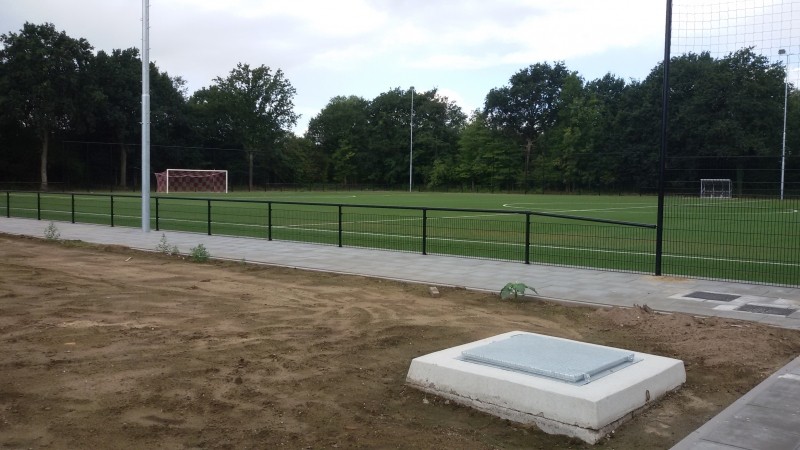De Neul Waterproof Sports Park
For years, De Neul sports park in Sint-Oedenrode had been struggling with soggy fields, even during mild rainfall. The problem could be attributed to the high water-level of its location, near the River Dommel. The wet sports fields would be relocated at great expense, but the municipal authorities, the football club, and the district water board have joined forces to convert the premises into a climate-resilient sports park.
Result
Rainwater collection underneath artificial turf fields
The sports park comprises 3 artificial turf fields and 3 natural turf fields. Underneath the artificial turf fields, rainwater will be stored in an underground peak water storage facility with a capacity of some 2,600 cubic metres (i.e., larger than an Olympic-sized swimming pool). The water will be collected by means of level-driven drainage and, if need be, transported to the natural fields. This technology enables the sports club to control the water level during dry and wet periods, and to decide on the purpose for which the collected water will be used.

Image: construction of De Neul waterproof sports park
Reuse of rainwater
Some of the collected rainwater will be reused to irrigate the natural fields. The water is irrigated near the grass roots in order to prevent wastage. By reusing rainwater, the club prevents dehydration of the soil. More information on the technologies used is provided in the video film below.
Collaboration
Through collaboration between the De Dommel district water board, the municipality of Meierijstad, the RKSV Rhode football club, Newae Engineers, and TopGrass Contractors, the climate-resilient sports park was designed and constructed under the budget available. The sports park can now cope with drought, torrential rain, and even floods.
Lessons to be learned
- Collaboration is important. In the purview of the renovation of De Neul sports park, a construction team was formed in which all the parties involved were represented. This also generated water awareness among all the parties.
-
Combining functions will enhance the output of a project. The elevated sandy soils in the province of Brabant are prone to dehydration. At this sports park, measures have been taken to return as much water as possible to the soil and to cut back on the use of groundwater. As a result, the project qualified for a grant under the Elevated Sandy Soils Delta Programme.
-
Information is power. How does the water storage facility perform? What reduction is achieved in terms of water drainage? How much water are we saving because of the irrigation system? A measurement plan has been drawn up to generate such information.
-
Heat is a point for attention in the design of sports parks. Which types of pavements are actually functional, and which can be excluded from consideration? Trees are very important in combating heat stress. The colour of the artificial turf infill material also affects the heat over the fields on hot days. De Neul sports park has opted for cork, a natural material.
Contact person
Hans Roelofs
Waterschap De Dommel
Hans.Roelofs@dommel.nl
